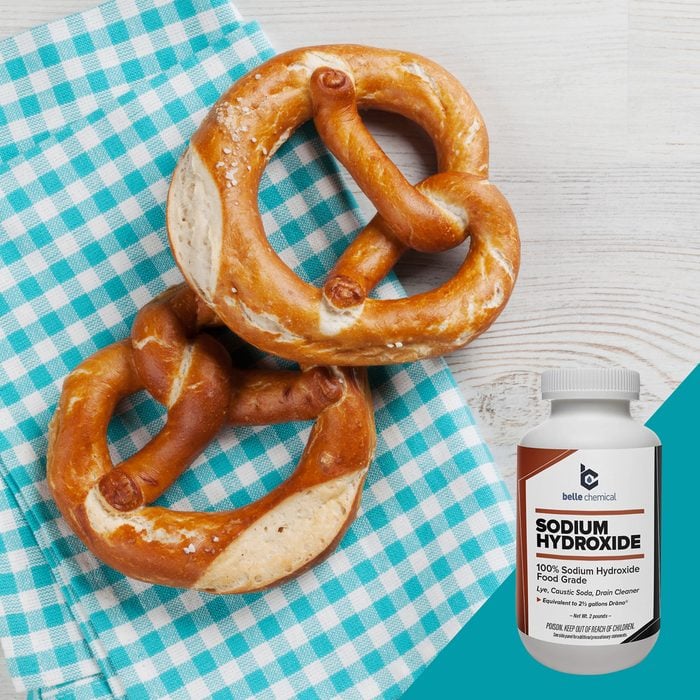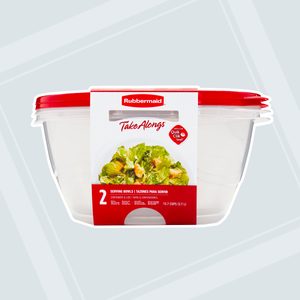How to Safely Use Food-Grade Lye for Pretzels
Updated: Jul. 12, 2022

Ditch the baking soda and learn how to make pretzels the old-fashioned way—by using a lye bath.
Our editors and experts handpick every product we feature. We may earn a commission from your purchases.
If you’ve ever wondered how to achieve that classic, deeply golden sheen on homemade pretzels, this article is for you. I’m talking about how to safely work with lye for pretzels.
Fair warning, you’re going to need to be adventurous, willing to purchase a slightly hazardous chemical and wear some personal protective equipment. It may sound scary, but this method will transform your homemade pretzels from good to glorious.
What Is Lye?
Lye—also known as sodium hydroxide—is an alkaline compound often used to make household cleaners, soap and detergents. It’s also used to provide authentic Bavarian-style pretzels with that golden color, rich flavor and sheen.
Lye affects the baking process in pretzels by speeding up the Maillard reaction that occurs on the outside of the pretzels as they bake. For baking newbies, the Maillard reaction is a chemical reaction that happens between the amino acids and sugars in bread dough that gives bread products their color while also imparting flavor.
You can achieve similar pretzel results with this trick using baked baking soda—but a lye solution is best.
Safety Tips for Baking Pretzels with Lye
The most important thing you need to know about lye is that it can be dangerous. As a caustic substance, when used or mixed improperly, lye can cause severe burns to bare skin, cause permanent eye damage and discolor working surfaces. Here are a few tips to keep you and your kitchen safe when working with lye.
Wear Personal Protective Equipment
Safety first! We advise wearing long sleeves and protective rubber or disposable gloves when working with lye. (Make sure you know how to safely remove gloves.) Wear closed-toe shoes and protective eye equipment to keep yourself safe from spills or splashes, too.
Finally, work in a well-ventilated space. Turn on your range hood’s fan or open a window, since inhaling sodium hydroxide can be hazardous if safety precautions are not taken.
Use Proper Mixing Equipment
A lye solution should not be mixed in just any container with just any spoon. When working with lye, you’ll want to use a non-reactive bowl since lye is caustic. We recommend a heavy, plastic container to be extra safe.
We do not recommend using glass or metal containers made from aluminum to mix a lye solution. Lye can etch (even Pyrex) over time and cause it to shatter and lye can (and will) dissolve aluminum, so do not mix the two.
Editor’s Tip: Not all plastics are created equal. The best way to know if your container is safe for mixing lye, check the recycling symbol and number printed on the container (typically on the bottom). A container labeled #2 (high-density polyethylene; HDPE) or #5 (polypropylene; PP) are best.
Protect Surfaces
As stated earlier, lye is caustic. It can damage or discolor certain materials, like butcher block and natural stone surfaces. Better safe than sorry, so lay down a plastic cutting board or pastry slip mat to protect those fancy marble countertops!
Dispose of Leftover Lye Safely
Keep a few rags handy to wipe up drips or spills immediately. Don’t wait till you’re done. When you finish dipping pretzels into the lye bath, pour any leftover solution down the drain of your kitchen sink. We recommend doing so with the cold water running.
As an extra precaution, to neutralize any lingering lye solution, pour a bit of vinegar down your drain and wipe your counters with a vinegar-soaked rag.
How to Make a Lye Bath for Pretzels
In many modern pretzel recipes (like this Chewy Soft Pretzel recipe), there will typically be a step that involves bringing a mixture of water and baking soda to a boil. The recipe will direct you to place the shaped, unbaked pretzels, one at a time, in the boiling water for a few seconds prior to baking.
When opting to use lye for pretzels, skip that step and replace it with the following process:
Step 1: Combine lye with cold water
To prepare a lye bath for pretzels, fill a large liquid measuring cup with four cups of cold water. Add the water to a heavy, plastic container and carefully mix with two tablespoons of food-grade lye until fully dissolved.
Editor’s Tip: Sodium hydroxide (lye) produces an exothermic reaction (which means it gets hot) when combined with water. Starting with ice-cold water ensures the lye solution remains at a safe temperature for handling.
Step 2: Dip the pretzels
Once your lye bath is properly mixed, carefully lower your unbaked pretzels into the solution for 10 to 15 seconds, then remove to a parchment-lined baking sheet. Bake as directed by your recipe.
Editor’s Tip: We like to use a heat-resistant, non-reactive stainless steel deep fryer spider to dip the pretzels into the solution.
Where to Buy Food-Grade Lye
Food-grade lye isn’t something you’ll find at most grocery stores, but it’s readily available on Amazon and sometimes at specialty baking retailers or restaurant supply stores.



